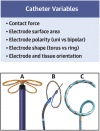Pulsed Field Ablation of Atrial Fibrillation: A Comprehensive Review
- PMID: 39076426
- PMCID: PMC11272841
- DOI: 10.31083/j.rcm2411337
Pulsed Field Ablation of Atrial Fibrillation: A Comprehensive Review
Abstract
Pulsed-field ablation (PFA) has emerged as a promising nonthermal ablation alternative for treating atrial fibrillation (AF). By delivering ultra-rapid high-energy electrical pulses, PFA induces irreversible electroporation, selectively targeting myocardial tissue while sparing adjacent structures from thermal or other damage. This article provides a comprehensive review of multiple pre-clinical studies, clinical studies, and clinical trials evaluating the safety, efficacy, and long-term outcomes of PFA in various settings and patient populations. Overall, the reviewed evidence highlights PFA's potential as a revolutionary ablation strategy for AF treatment. Offering comparable procedural efficacy to conventional ablation methods, PFA distinguishes itself with shorter procedure times and reduced risks of complications such as phrenic nerve palsy and potential esophageal injury. While further research is warranted to establish long-term efficacy, PFA's distinct advantages and evolving clinical evidence suggest a promising future for this novel nonthermal ablation approach. As PFA continues to advance, it has the potential to transform AF ablation procedures, providing a safer alternative for patients with atrial fibrillation.
Keywords: atrial fibrillation; catheter ablation; pulsed-field ablation.
Copyright: © 2023 The Author(s). Published by IMR Press.
Conflict of interest statement
Dr. Zei, Dr. Romero, and Dr. Osorio report consulting and research support from Biosense Webster. Dr. Romero reports consulting for Boston Scientific. Neither honoraria nor payments were made for authorship.
Figures






References
-
- Wang L, Ze F, Li J, Mi L, Han B, Niu H, et al. Trends of global burden of atrial fibrillation/flutter from Global Burden of Disease Study 2017. Heart (British Cardiac Society) . 2021;107:881–887. - PubMed
-
- Kleindorfer DO, Towfighi A, Chaturvedi S, Cockroft KM, Gutierrez J, Lombardi-Hill D, et al. 2021 Guideline for the Prevention of Stroke in Patients With Stroke and Transient Ischemic Attack: A Guideline From the American Heart Association/American Stroke Association. Stroke . 2021;52:e364–e467. - PubMed
-
- Freeman JV, Simon DN, Go AS, Spertus J, Fonarow GC, Gersh BJ, et al. Association Between Atrial Fibrillation Symptoms, Quality of Life, and Patient Outcomes: Results From the Outcomes Registry for Better Informed Treatment of Atrial Fibrillation (ORBIT-AF) Circulation. Cardiovascular Quality and Outcomes . 2015;8:393–402. - PubMed
-
- Heist EK, Ruskin JN. Atrial fibrillation and congestive heart failure: risk factors, mechanisms, and treatment. Progress in Cardiovascular Diseases . 2006;48:256–269. - PubMed
Publication types
LinkOut - more resources
Full Text Sources
Research Materials

